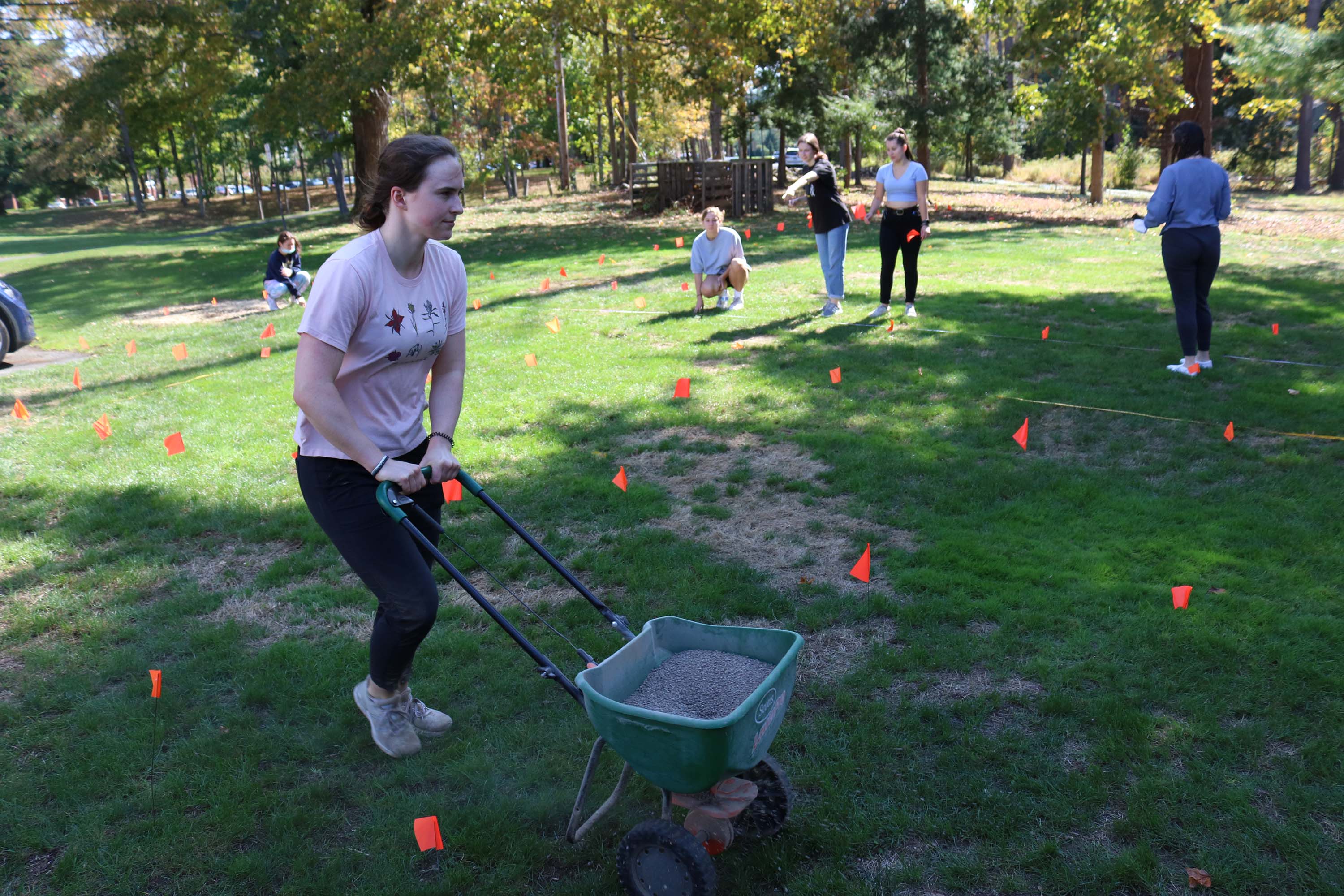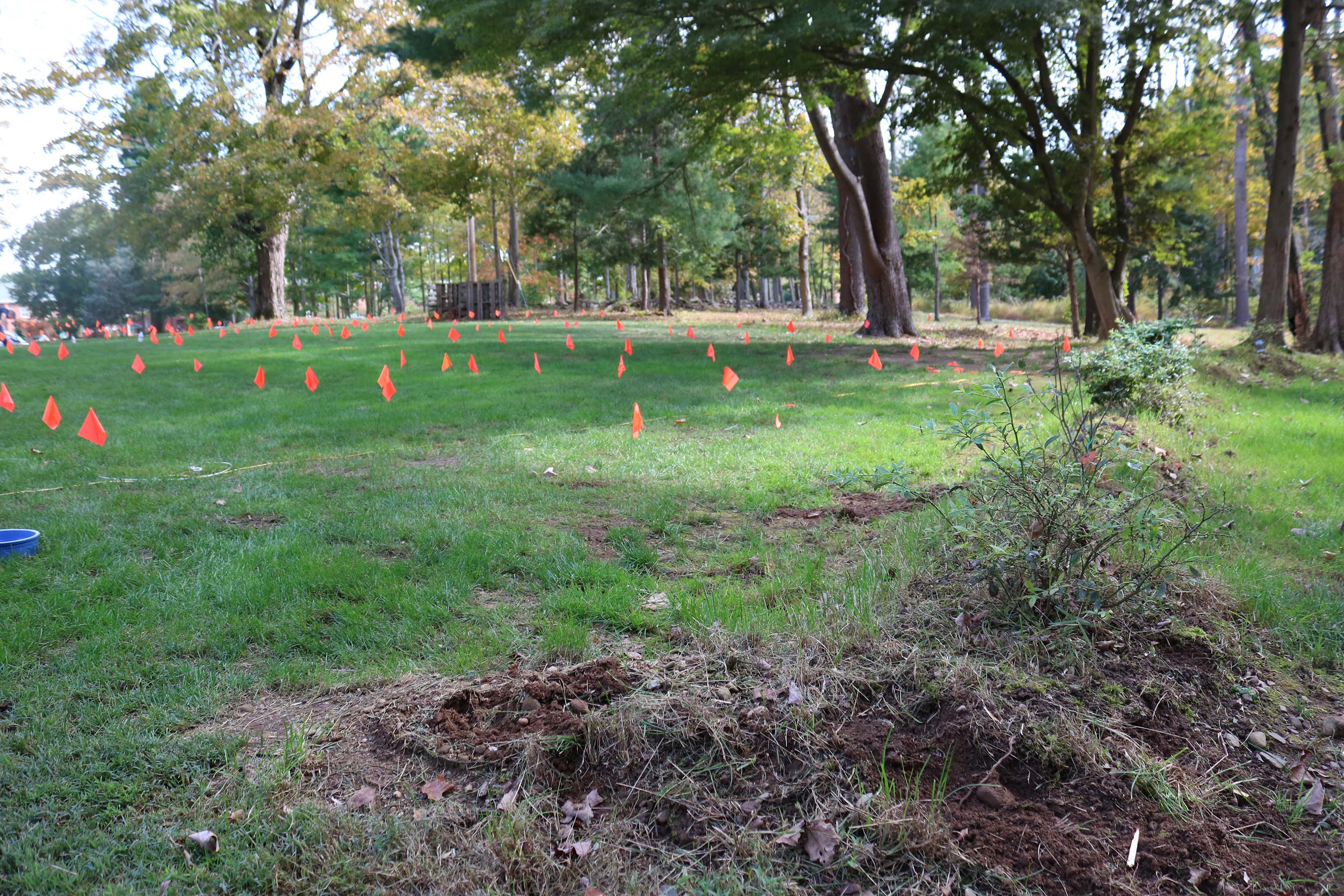
What happens when a bee flies nearby? Creators of a community garden would suggest thinking twice before swatting it down.
The Albert Schweitzer Institute and Students for Environmental Action kicked off a multi-semester effort to build a garden to support pollinators while creating a relaxing spot for Quinnipiac University students on Oct. 8.

“Our native pollinators are responsible for about one in every three bites of food that we eat,” said Sarah Lawson, assistant professor of biology. “They allow our plants to flower and fruit. So pretty much any of your major fruits and vegetables are brought to us by our pollinators, and we are seeing a short decline in the populations of all of our pollinators and all of our insects generally.”
Lawson helped coordinate this event with the institute and student group, bringing her ecology class to line the garden with flags to establish the groundwork for the garden. Following a hand-drawn design akin to a treasure map, Lawson, her students and various volunteers worked together on a sunny Friday to start the path toward a garden.
“[The garden] will be kind of like a refuge to bring our pollinators back to Quinnipiac,” Lawson said.
However, Lawson was not the architect of the aforementioned treasure map. That would be Nancy DuBrule-Clemente, owner of NatureWorks in Northford, Connecticut. DuBrule-Clemente first connected with Lawson when the Quinnipiac professor brought graduate students to her organic garden center to study pollinators on native plants.
“When I met (Lawson), I was like ‘You know all the bugs. I know all the plants, and I’m learning the bugs,” DuBrule-Clemente said with a laugh. “So it’s just a great match-up.”
Planning a garden requires more thought than one may think. DuBrule-Clemente said she had to consider the light availability to decide where certain plants could be planted. The sun is much more prevalent in the road-side part of the garden, while the deeper parts receive more shade.
I’ve been pushing this for my whole life, and to see it happen in a venue like this, it’s fabulous.”
Nancy DuBrule-Clemente, owner of NatureWorks
DuBrule-Clemente said she considered soil and drainage, the latter of which was solved by a makeshift swale designed to stop the water from running.
She also pointed out a nearby plant — Japanese knotweed — as a serious danger to the garden. An invasive plant, DuBrule-Clemente said Japanese knotweed could “eat up the world and kill everything.” It requires constant mowing to maintain the garden’s security.

Once approved, DuBrule-Clemente will create detailed planting plans for garden beds to be installed next spring. The beds will be divided into sections: bee-pollinated plants, shrubberies, open soil, a rainbow section that will include various colors and an Indigenous section with relative herbs. It will be a pesticide-free garden that blooms from May to November.
“I’ve been pushing this for my whole life, and to see it happen in a venue like this, it’s fabulous,” DuBrule-Clemente said.
The garden will serve as an important learning opportunity for students. Those interested in pollinators and biology, more specifically ecology, will have a space to hone their craft.
DuBrule-Clemente said that there will be teaching areas for classes to discuss their findings from the garden.
“In the years to come, if students want to study pollinators they’re just going to walk out the door and they’re going to walk through here,” DuBrule-Clemente said.
Gabrielle Pena, the president of the student group, has taken two environmental studies courses abroad, and familiarized herself with Lawson’s research. She started this pollination project over the summer as her independent study.
[The garden is] not only for the research, but also a place where students can come, sit and maybe meditate for a second. Get away from the busyness of school.”
Gabrielle Pena, president of Students for Environmental Action
Marking up the garden with small orange flags might not look like much, but it was a culmination of hard work for Pena.
“It’s just really amazing because it’s all of the pieces coming together,” Pena said.
Pena said that, in addition to the garden’s research and learning opportunities, it will also serve as a “sanctuary” for students.
“[The garden is] not only for the research, but also a place where students can come, sit and maybe meditate for a second,” Pena said. “Get away from the busyness of school.”

One garden might not defeat climate change, but Pena said that it’s a move in the right direction.
“I really have a passion for — this is cliché — but changing the world for better,” Pena said. “I always say you don’t have to make giant leaps. You can make small steps that build up to achieve something grand.”
It was a sentiment echoed by many people at the event, including volunteer first-year English major Colin Bullock.
“If enough people get together and do something as small as planting a tree or as big as making a complete community garden for pollinators I feel like we can make a major difference,” Bullock said.
The garden will be dug and maintained this season before planting in the spring.


4 replies on “New Quinnipiac community garden is all the buzz”
So nice to see young people getting involve with the environment. Great article
This sort of community involvement, with an articulate view to values shared and in need of pursuit in the larger world, both social and natural, is at the very heart of what education ought to be. All of the other academic skills fit somewhere to support this hierarchy of value. Well done!
How wonderful that Gaby Pena and the Students are such leaders, advocates and examples for us all! Bravo and thanks!
This is such a great project to be a part of. It is exactly what pur enviroment needs. The hard work from everyone involved is appreciated.